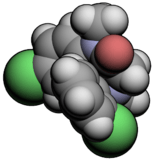Mexazolam
 | |
 | |
| Clinical data | |
|---|---|
| Trade names | Melex, Sedoxil |
| AHFS/Drugs.com | International Drug Names |
| Routes of administration | Oral |
| ATC code | none |
| Legal status | |
| Legal status |
|
| Pharmacokinetic data | |
| Metabolism | Hepatic (CYP3A4) |
| Excretion | Renal |
| Identifiers | |
| |
| Synonyms | 13-chloro- 2-(2-chlorophenyl)- 5-methyl- 3-oxa- 6,9-diazatricyclo[8.4.0.02,6] tetradeca- 1(10),11,13-trien- 8-one |
| CAS Number | 31868-18-5 |
| PubChem (CID) | 4177 |
| ChemSpider |
4033 |
| UNII |
S5969B6237 |
| KEGG |
D01316 |
| Chemical and physical data | |
| Formula | C18H16Cl2N2O2 |
| Molar mass | 363.237 g/mol |
| 3D model (Jmol) | Interactive image |
| |
| |
| (verify) | |
Mexazolam[1] (marketed under the trade names Melex and Sedoxil)[2] is a drug which is a benzodiazepine derivative.[3] Mexazolam has been trialed for anxiety and was found to be effective in alleviating anxiety at one week follow-up, however, after three weeks of therapy mexazolam had lost its therapeutic anxiolytic properties becoming no more effective than placebo, presumably due to benzodiazepine tolerance.[4] Mexazolam is metabolised via the CYP3A4 pathway. HMG-CoA reductase inhibitors including simvastatin, simvastatin acid, lovastatin, fluvastatin, atorvastatin and cerivastatin inhibit the metabolism of mexazolam,[5] but not the HMG-CoA reductase inhibitor pravastatin.[6][7]
See also
References
- ↑ DE Patent 1954065
- ↑ "Benzodiazepine Names". non-benzodiazepines.org.uk. Retrieved 2009-04-05.
- ↑ Kurono, Y; Kamiya, K; Kuwayama, T; Jinno, Y; Yashiro, T; Ikeda, K (1987). "Kinetics and mechanism of the acid-base equilibrium of mexazolam and comparison with those of other commercial benzodiazepinooxazole drugs". Chemical & pharmaceutical bulletin. 35 (9): 3831–7. doi:10.1248/cpb.35.3831. PMID 2893667.
- ↑ Ferreira, L; Figueira, ML; Bessa-Peixoto, A; Marieiro, A; Albuquerque, R; Paz, C; Cerqueira, A; Damião, P; et al. (2003). "Psychomotor and anxiolytic effects of mexazolam in patients with generalised anxiety disorder". Clinical drug investigation. 23 (4): 235–43. doi:10.2165/00044011-200323040-00003. PMID 17535036.
- ↑ Mc Donnell, CG; Harte, S; O'driscoll, J; O'loughlin, C; Van Pelt, FN; Shorten, GD (2003). "The effects of concurrent atorvastatin therapy on the pharmacokinetics of intravenous midazolam". Anaesthesia. 58 (9): 899–904. doi:10.1046/j.1365-2044.2003.03339.x. PMID 12911366.
- ↑ Ishigami, M; Takasaki, W; Ikeda, T; Komai, T; Ito, K; Sugiyama, Y (2002). "Sex difference in inhibition of in vitro mexazolam metabolism by various 3-hydroxy-3-methylglutaryl-coenzyme a reductase inhibitors in rat liver microsomes.". Drug metabolism and disposition: the biological fate of chemicals. 30 (8): 904–10. doi:10.1124/dmd.30.8.904. PMID 12124308.
- ↑ Ishigami, Michi; Honda, Tomoyo; Takasaki, Wataru; Ikeda, Toshihiko; Komai, Toru; Ito, Kiyomi; Sugiyama, Yuichi (2001). "A Comparison of the Effects of 3-Hydroxy-3-Methylglutaryl-Coenzyme A (HMG-CoA) Reductase Inhibitors on the CYP3A4-Dependent Oxidation of Mexazolam in Vitro". Drug Metabolism and Disposition. 29 (3): 282–8. PMID 11181496.
This article is issued from Wikipedia - version of the 6/24/2016. The text is available under the Creative Commons Attribution/Share Alike but additional terms may apply for the media files.